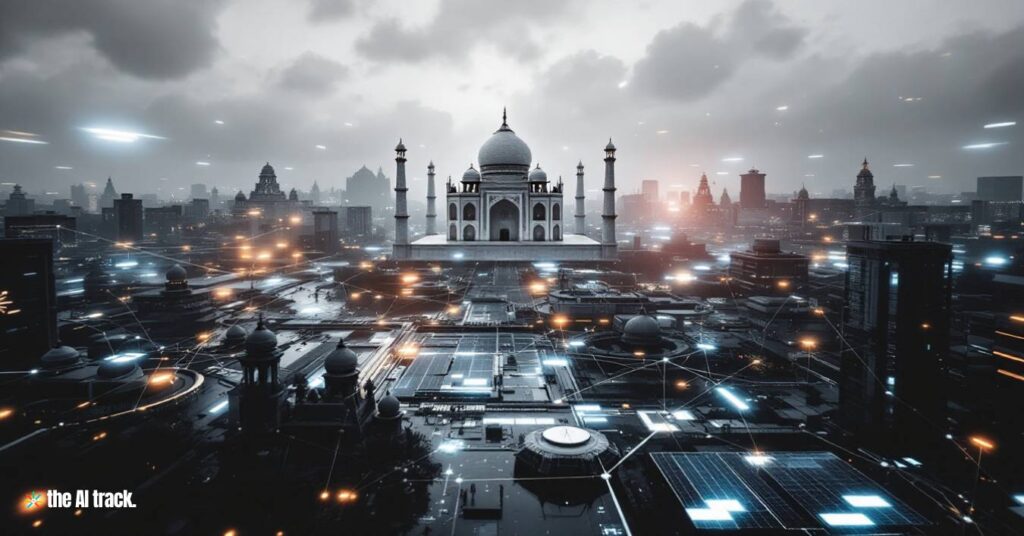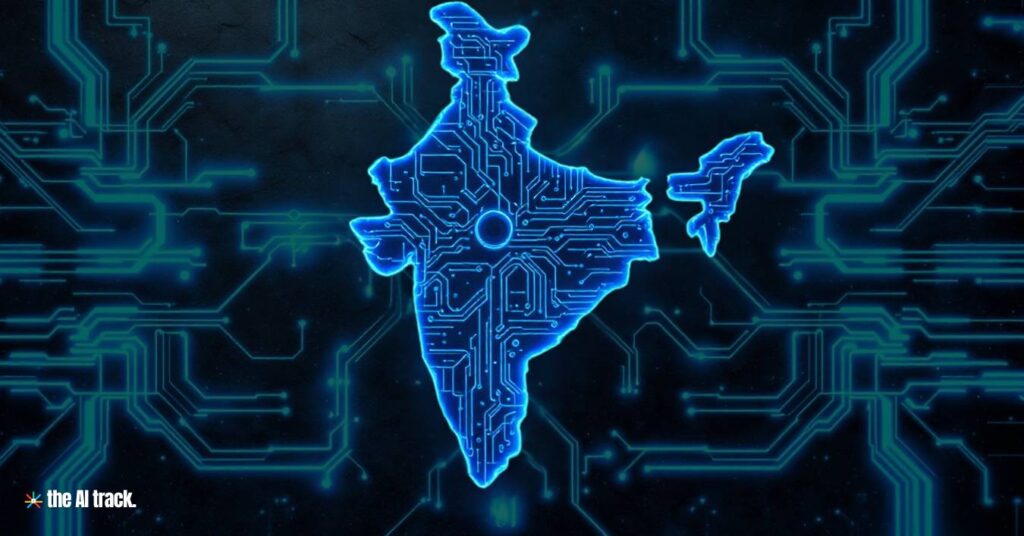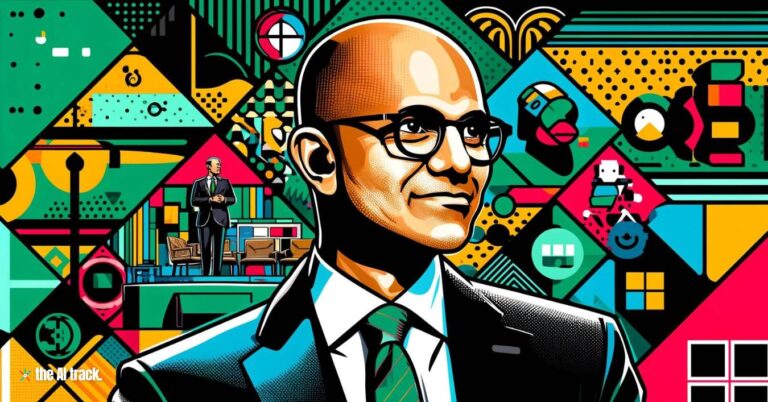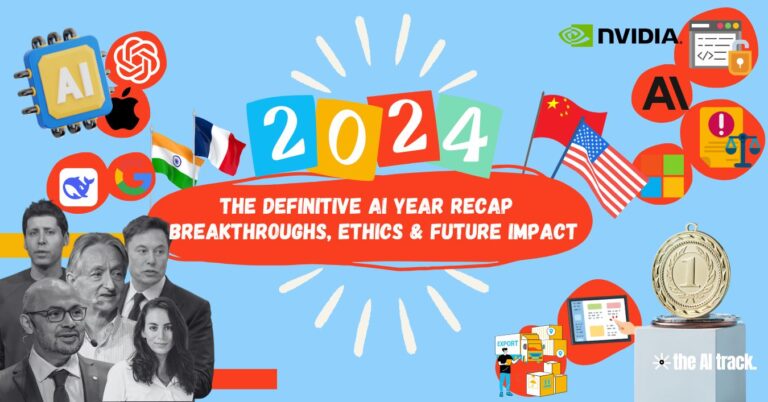India is executing a bold, multi-pronged strategy to dominate the global artificial intelligence (AI) landscape. Combining ambitious government policies, a world-class talent pipeline, cutting-edge infrastructure projects, and transformative public-private partnerships, the nation is positioning itself as both an AI innovation hub and a blueprint for ethical, inclusive technological advancement. With initiatives targeting a $500 billion GDP contribution by 2030, India is rewriting the rules of AI-driven development.
Jump to Sections

Government Initiatives and Strategic Frameworks
AI for India 2030 Initiative: A $500 Billion Vision
Launched in January 2024 by the Ministry of Electronics and IT (MeitY) in partnership with Nasscom and the World Economic Forum’s C4IR India, this flagship program integrates with the broader IndiaAI Mission to drive AI adoption across critical sectors. Key components include:
- Strategic Playbooks:
- Future Farming Playbook: Aims to optimize crop yields using AI-powered drones, soil sensors, and predictive analytics, building on successes like the Bill & Melinda Gates Foundation’s AI agriculture program, which boosted yields by 21% for 7,000 farmers.
- Future SMEs Playbook: Guides MSMEs on AI adoption for inventory management, customer engagement, and financial planning, targeting India’s 63 million MSMEs that contribute 30% of GDP.
- AI Sandbox: A testing ecosystem launching in late 2024 offering startups access to curated datasets, mentorship, and computing resources, democratizing AI innovation.
- Ethical AI Governance: Anchored by participation in the AI Governance Alliance, India is shaping global norms while developing “sovereign AI” systems tailored to local languages, cultural contexts, and socio-economic needs.

Foundational Policies and Investments
- IndiaAI Mission: Backed by $1.2 billion in government funding, this March 2024 initiative prioritizes AI infrastructure, including a one-gigawatt data center in Gujarat (with Reliance and NVIDIA’s Blackwell chips) and the AI4Bharat lab at IIT Chennai, which develops models for India’s 22 official languages.
- Digital Public Infrastructure (DPI) Integration: Leveraging platforms like Aadhaar (1.4 billion users) and UPI (14 billion monthly transactions), AI is being scaled for predictive agriculture (e.g., crop yield algorithms) and healthcare (e.g., mobile-first diagnostic tools).
- National AI Skilling Framework: Targets 500,000 developers through partnerships with NVIDIA and IT giants, while embedding AI education starting at grade 6.
The Quest for AI Supremacy: Strategies for Global Leadership

The pursuit of AI supremacy is underway. The strategies nations are employing to lead in AI, from talent acquisition to ethical frameworks, and their implications.

Talent and Infrastructure: Building the AI Backbone
Workforce Development
- India produces 1.5 million engineering graduates annually, with 4.7 million working in AI/ML roles globally. NVIDIA’s upskilling partnerships with Infosys, TCS, Wipro, and Tech Mahindra aim to add 500,000 AI-ready developers by 2025.
- Microsoft’s Skilling Initiative: Committed to training 10 million people in AI skills by 2030, the company has already surpassed its 2024 goal by training 2.4 million individuals, with 65% women and 74% from tier II/III cities, bridging urban-rural and gender divides.
- Institutions like Mahindra University and Universal AI University offer specialized programs, while Jio Institute provides cloud resources to startups.
Cutting-Edge Infrastructure
- Yotta’s Mumbai Data Center: Offers 16 exaflops of AI compute power, supporting projects like Sarvam AI’s Hindi LLMs.
- Reliance-NVIDIA Gujarat Facility: A 1-gigawatt AI data hub deploying Blackwell chips—critical for training sovereign AI models like Indus 2.0, a Hindi/regional language model serving 600 million speakers.
- Tech Mahindra’s Indus 2.0: Focused on retail and healthcare, this model exemplifies India’s push for linguistic inclusivity in AI.

Reliance’s 3-Gigawatt Jamnagar Data Center: A Global Benchmark
Reliance Industries is constructing the world’s largest AI data center in Jamnagar, Gujarat, with a 3-gigawatt capacity—five times larger than Microsoft’s largest facility (600 MW in Virginia). Key details:
- Cost & Timeline: Estimated $20–30 billion, with completion targeted within 24 months, leveraging Reliance’s expertise in rapid infrastructure scaling.
- Renewable Energy Integration: Part of a 5,000-acre green energy complex producing solar, wind, hydrogen, and battery storage. Aligns with India’s 50% renewable energy target by 2030, though intermittent supply may require fossil fuel backups or nuclear partnerships (e.g., TerraPower).
- Strategic Location: Jamnagar, Prime Minister Modi’s home state, already hosts Reliance’s world-class oil refining complex, now transforming into a renewable-AI nexus.
- Market Disruption: Reliance plans to offer lowest-in-the-world AI inferencing costs, mirroring its telecom pricing strategy to democratize access.
Regional Expansion:
- Hyderabad: Emerging as a data center hub, with CtrlS and Ursa Clusters developing facilities.
- Microsoft’s Data Center Expansion: With three existing data centers and a fourth planned for 2026, Microsoft’s $3 billion investment will expand cloud and AI infrastructure across 20+ cities, including Bengaluru.
Global Context: Competes with OpenAI’s $500 billion Stargate Project and Microsoft’s 1.2-GW Portugal facility, addressing a projected 15-gigawatt U.S. capacity shortfall by 2030.
Chinese organizations have launched a total of 79 large-language models (LLMs) since 2020, a significant increase from 2020

Sectoral Transformation: AI’s Ground-Level Impact
Agriculture
- AI solutions address challenges for 263 million farmers, with predictive analytics reducing water/fertilizer use by 15-20% and IoT-enabled drones improving pest detection accuracy by 30%.
- Microsoft’s Collaboration with Digital Green: Leveraging AI to enhance agricultural productivity through personalized advisory services for smallholder farmers.
Healthcare
- AI Diagnostics: Tools for diabetes-related retinopathy have cut misdiagnoses by 25% in trials, critical for India’s 101 million diabetic patients. NVIDIA’s healthcare partnerships aim to reduce rural treatment times by 15-20%.
- Telemedicine: Platforms like eSanjeevani (1.4 billion consultations) use AI to prioritize cases and predict outbreaks.
Education
- Microsoft’s AI Innovation Network: Partnered with Physics Wallah to integrate AI into education, enabling personalized learning for over 6 million students through adaptive tools and automated grading systems.
MSMEs and Urban Development
- AI-driven tools help MSMEs automate workflows, with early adopters reporting 20-30% efficiency gains.
- Smart Cities: AI optimizes traffic flow in Delhi and Mumbai, reducing congestion by 18% during pilot phases, while energy management systems cut municipal power waste by 12%.
Telecommunications and E-Commerce
- Reliance’s JioBrain: AI tools enhance network optimization and customer service, while Flipkart’s AI chatbots handle 40% of customer inquiries, reducing resolution times by 50%.

Global Collaborations and Sovereign AI
Strategic Partnerships
- NVIDIA: With 4,000 engineers in India, NVIDIA collaborates with Reliance on AI factories and supports sovereign AI through local language models. CEO Jensen Huang declared India will shift from “software exporter to AI exporter.”
- Microsoft:
- $3 Billion Investment: Expanding AI and cloud infrastructure, fostering SaaS startups via SaaSBoomi (impacting 5,000 startups and 150,000 employees).
- GitHub Copilot: Achieved a $2 billion annual run-rate, demonstrating the scalability of AI tools in India’s developer ecosystem.
- Meta: Open-source AI projects target India’s 800 million internet users, emphasizing regional language support.
Geopolitical Positioning
As U.S.-China tech tensions rise, India attracts $3.5 billion in AI FDI (2023-24) and $3 billion from Microsoft, with NVIDIA, Microsoft, and Meta establishing regional hubs. The AI market, growing at 20% CAGR, positions India as a stable alternative for global tech investment.
AI in military: Unleashing game-changing potential in intel, surveillance, precision, and autonomy. Yet, it sparks deep questions.

Ethical and Inclusive Growth
- Sovereign AI: Prioritizes data localization and contextual relevance, exemplified by Karya’s ethical data sourcing (paying rural workers 20x minimum wage for AI training data).
- Equitable Job Creation: AI skilling programs target 10 million workers in vulnerable sectors by 2027, with a focus on women and rural populations.
- Sustainability: Microsoft leads with commitments to be carbon negative, water positive, and zero waste by 2030, setting benchmarks for ethical AI infrastructure.
- AI Governance Alliance: India advocates for global ethical standards, sharing frameworks like the National Data Governance Policy to balance innovation with privacy.

Conclusion: Redefining Global AI Leadership
India’s AI strategy—combining scale, innovation, and inclusivity—offers a template for the Global South. With $500 billion in projected economic impact by 2030, the nation is transitioning from a tech outsourcer to an AI product leader. Key to this success is the synergy between public infrastructure (DPI), private sector agility (e.g., Reliance’s 3-gigawatt Jamnagar megaproject, Microsoft’s $3 billion investment), and global partnerships (NVIDIA, Microsoft).
Microsoft’s expansion of data centers, skilling initiatives, and SaaS ecosystem development complements Reliance’s infrastructure push, addressing 219 gigawatts of projected global data center demand by 2030 while prioritizing sustainability. As AI reshapes sectors from farming to finance, India’s focus on ethical, sovereign models ensures its advancements benefit all 1.4 billion citizens while setting new benchmarks for global AI governance. In the words of NVIDIA’s Jensen Huang, “India’s moment is now”—a moment poised to redefine 21st-century technological leadership.
India and AI - Key Takeaways
- $500B Economic Vision: India’s AI initiatives aim to contribute $500B to GDP by 2030, targeting sectors like agriculture, healthcare, and MSMEs.
- Mega Infrastructure: Reliance’s 3-gigawatt AI data center in Jamnagar (world’s largest) and Microsoft’s $3B investment in cloud/AI infrastructure position India as a global AI leader.
- Sovereign AI Focus: Development of local language models (e.g., Indus 2.0) and ethical data practices (Karya) to ensure AI aligns with India’s linguistic and cultural diversity.
- Global Collaborations: Partnerships with NVIDIA, Microsoft, and Meta drive innovation, including NVIDIA’s 500,000 developer upskilling and Microsoft’s 10M AI-skilling pledge.
- Sectoral Impact:
- Agriculture: AI boosts yields by 21% and reduces water/fertilizer use by 15-20%.
- Healthcare: AI cuts misdiagnoses by 25% and speeds rural treatment by 15-20%.
- Smart Cities: AI reduces urban congestion by 18% and energy waste by 12%.
- Ethical & Inclusive Growth: Emphasis on job creation (10M workers trained by 2027), gender equity (65% women in Microsoft’s AI training), and sustainability (carbon-negative AI infrastructure).
- Geopolitical Rise: Attracts $6.5B+ in AI FDI (2023–24) as U.S.-China tensions push tech giants to invest in India’s stable, high-growth market (20% CAGR).
Sources
- The Present and The Future of India’s AI Infrastructure | IndiaAI, [Publication Date]
- India to have 20x more AI compute infra by 2024: NVIDIA CEO | Fortune India
- Reliance, Nvidia partner to build large-scale AI infrastructure in India | India Today, October 24, 2024
- How India can harness the power of AI to become a trailblazer | The Indian Express
- Meta teams up with IndiaAI to advance open source AI innovation, R&D, skill development | Business Standard, India News
- NVIDIA forms AI partnerships with multiple Indian companies | Yahoo Finance
- Nvidia signs a slew of AI deals in India push | TechCrunch, October 23, 2024
- Nvidia’s Huang Teams With Asia’s Richest Man on Blackwell AI Hub | Yahoo Finance
- Nvidia: Nvidia announces partnerships with Indian tech firms, corporates around Jensen Huang’s visit | The Economic Times
- ‘India Should Manufacture Its Own AI,’ Declares NVIDIA CEO | NVIDIA Blog
- The Future of AI and India: Public and Private sectors build Indian AI | Forbes








